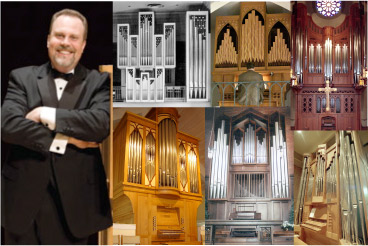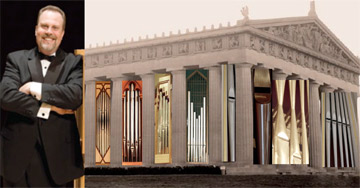Making Music City Mixture : Planning
 Saturday, June 23, 2012 at 12:00PM
Saturday, June 23, 2012 at 12:00PM Part 2 of a multi-part narrative of my new recording on mechanical action organs of Nashville. Music City Mixture is available here.
Planning
I have self-recorded for many years – things like practice sessions and run-throughs to catch those things one may not hear in the heat of battle. Recording like that is always instructive, minimally time-intensive – and intimidating. I always dread listening to my own playing as an audience member; it makes me more nervous than walking out to play a recital for organists. But after all those years, plus making three previous recordings (two of which were not released) the exercise of listening to a professional recording opened up a new idea: at one point during our Nashville sessions, Rich Mays had me listen back to a passage that he as an organist thought needed to be phrased/shaped/lifted here and there. I listened and concluded, “It sounds like ME. Let’s keep it.” With that, I arrived at the words to express what I had thought for years about performing and recording: Sound like yourself – communicate what you have to say, and the listening audience will hear it.
This project was conceived with a much grander number of instruments intended for inclusion. We were going to record on all the big ones and virtually all the pretty ones. But these multi-venue projects have a way of defining their own parameters as things progress. The project started getting unwieldy and focus-poor. Add to that the logistical nightmare of coordinating schedules among so many venues for only one available week of recording sessions. One roadblock led to another, red tape increased in some places, and unreturned phone calls and emails languished in others (names withheld here, but I am this close…). Engineer and producer Rich Mays saved the day when he noticed our thoughts and plans kept returning to the same handful of deserving organs, all of which happened to be mechanical action. An accident in one way, but a wonderful re-definition of the project! By paring down to the “trackers,” the project’s focus sharpened immediately, and everything carried on much more smoothly from that point on. I backtracked to the “electric action” venues and told them we were scaling back. Everyone understood completely, and I did not encounter a sourpuss anywhere. That is a phenomenon that does not exist everywhere, dear Reader, but I have come to appreciate it so much from the Nashville Chapter of the AGO.
What music to record? And where to record each piece? I believe a recital instrument is much easier to plan for than a recording instrument. With a recital, I get a one-time shot to play for the audience, maybe an archive recording of it is captured, and it’s over. With a recording instrument, everything is laid bare in perpetuity to be played and replayed by any number of listeners (and critics). I chose a large handful of music and started practicing, pondering, and paring down. This piece might work here, this piece might work there, this piece would work anywhere, this piece is too hard, this piece will pair well with this one, and so on. Decisions were made, and off we went to Nashville. You’ll find program notes for all the pieces at the Program Notes tab of this website.
The Gawthrops and I talked and re-talked about a recording title. We made attempts at tying in “Music City” with “mechanical action” or with “the Athens of the South” or with my last name. Of course, the hare-brained titles started showing up, and the laughter derailed the proceedings for a while. “Bell Plays Nashville Belles,” “A Music City Bell,” and so forth. “A Mechanic Visits the Music City” made me sound non-musical (but my father attended mechanic school in Nashville, which would have brought things full-circle in a different way). Shooting a photo of me in a tux in the middle of a Tennessee horse farm just didn’t seem to do it for us, either. Showing me leaning against all six organs was a little more appealing:

Showing me leaning against the Parthenon replica in Nashville’s Centennial Park, with pipes from the six organs peeking between the columns, was even more appealing:

But we were afraid the casual observer wouldn’t get the reference (“What do those columns have to do with anything?”). Enter Bradley Gawthrop, who offered “Music City Mixture.” Everyone froze and made the quick mental trip to the double entendre of ‘mixture’ denoting both an organ stop and this compilation. Perfect. The title was settled. There is a reason I surround myself with people smarter than I.
Lodging had been worked out months before. I was all set to choose a hotel more or less centrally located to the venues. But when I made initial contact with Jennie Lou Smith about recording on the Casavant in Wightman Chapel, not only did she give an enthusiastic Yes to the project, but she also immediately offered the use of her home, right in town. So the lodging question was now settled, much more cheaply and far more luxuriously! In addition to Jennie’s refreshing straightforwardness and encyclopedic knowledge of organists far and wide, there were two delights involved with staying in her elegant home. Her husband, James Gooch, estate-planning attorney by day, is Chairman of the Board of Directors for the Nashville Symphony. Imagine the lively and stimulating conversations with this engaging and charming couple! Despite the pressures of hitting all the right notes and hoping that organs were in tune and the rooms quiet, the lodging arrangements and the company we kept could not have been more revitalizing. Another unexpected delight was in playing their piano for hours. James loves Beethoven Sonatas and all manner of Romantic fare, as do I, and I was all too happy to oblige with playing for him and Jennie. It is remarkable how playing the piano became a great way to relax during an organ recording project. We enjoyed conversations on great music, and I was delighted to have introduced Jennie to the Rachmaninoff Moment Musical in D-flat. Surely in-home musicales like that had to have been the delight of the great composers back in the day. There is something more than mildly invigorating about gathering around music to unwind after a long day. That, plus red wine or Scotch.
 Joby Bell | tagged
Joby Bell | tagged  Music City Mixture
Music City Mixture 